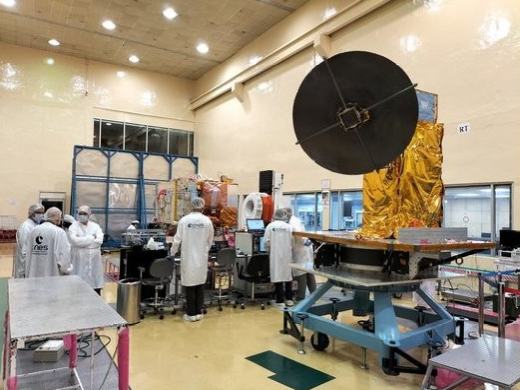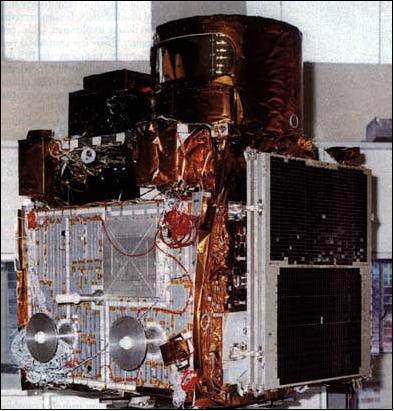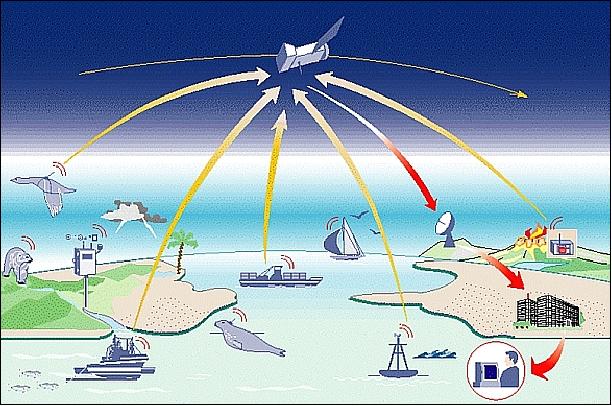Oceansat-3
EO
Ocean colour instruments
Atmosphere
Ocean
Launched in November 2022, Oceansat-3, also known as Earth Observing Satellite 6 (EOS-6), is an oceanographical Earth observation mission, and is the third in the Oceansat series from the India Space research Organisation (ISRO). It aims to provide service continuity for users of Oceansat-2 data, as well as improve upon existing remote sensing capabilities in the field of oceanography.
Quick facts
Overview
| Mission type | EO |
| Agency | ISRO |
| Mission status | Operational (nominal) |
| Launch date | 26 Nov 2022 |
| Measurement domain | Atmosphere, Ocean |
| Measurement category | Ocean colour/biology, Aerosols, Surface temperature (ocean), Ocean surface winds |
| Measurement detailed | Ocean chlorophyll concentration, Aerosol Extinction / Backscatter (column/profile), Sea surface temperature, Wind vector over sea surface (horizontal) |
| Instruments | A-DCS4, OCM (Oceansat-3), Scatterometer (Oceansat-3), SSTM-1 (Oceansat-3) |
| Instrument type | Ocean colour instruments, Imaging multi-spectral radiometers (vis/IR), Scatterometers, Data collection |
| CEOS EO Handbook | See Oceansat-3 summary |

Summary
Mission Capabilities
Oceansat-3 carries three instruments, the Oceansat Scatterometer (OSCAT-3), the Ocean Colour Monitor (OCM-3), a Sea Surface Temperature Monitor (SSTM) and the ARGOS-4 data collection system, also known as the Advanced Data Collection System (ADCS-4). OSCAT-3 is a radar scatterometer that aims to measure wind speeds and vectors at sea level, while OCM-3 is a 13-channel medium-resolution spectro-radiometer that collects ocean colour data. SSTM is a multi-purpose VIS/IR (Visible/Infrared) imaging radiometer that will work in conjunction with OCM-3 to determine potential fishery zones.
Performance Specifications
OSCAT-3 has a spatial resolution of 25 km, with a swath width of 1440 km. As a radar scatterometer, it operates in the Ku-band, with a frequency of 13.515 GHz. OCM-3 has a spatial resolution of 360 m, with a maximum swath width of 1400 km. OSCAT-3 operates in the Visible (VIS) and Near-Infrared (NIR) bands, with a wavelength range of 0.4 µm - 1.3 µm. SSTM images in two bands with a spatial resolution of 1080 m, and a swath width of 1440 km. It can resolve sea surface temperatures down to 0.15 K (0.15 °C / 0.27 °F) at a mean temperature of approximately 300 K (27 °C / 80 °F).
Oceansat-3 operates in a sun-synchronous orbit of altitude 720 km, with an inclination of 98.28°, an orbital period of 99.31 minutes, and a Local Solar Time (LST) on descending node of 1200 hours.
Space and Hardware Components
Oceansat-3 uses the IRS-1 (Indian Remote Sensing Satellite-1) bus of previous ISRO missions such as IRS-1A and -1B. The bus has a mass of 1117 kg, with star sensors, and Earth sensor and gyroscopes for attitude sensing, and various systems for attitude control. Oceansat-3 also carries the ARGOS-4 data collection system, also known as Advanced Data Collection System (ADCS-4), provided by the National Centre for Space Studies (CNES) of France. ARGOS-4 receives and retransmits data from ocean and land-based remote observing platforms or transponders. It operates at a carrier frequency of 401.65 MHz with a bandwidth of 110 kHz, enabling a data rate range of 400 to 4800 bit/s.
Overview
Oceansat-3, also known as EOS-6 (Earth Observation Satellite 6), is the third and most recent installation of the Indian Space Research Organisation’s (ISRO) Oceansat series. The satellite is a multi-sensor mission that aims to provide service continuity for users of Oceansat-2 data, as well as improve upon existing remote sensing capabilities in the field of oceanography. Oceansat-3 data has applications in ocean colour, biology, and surface winds and temperature. Oceansat-3 also carries the ARGOS-4 data collection system, as part of a partnership with the National Centre for Space Studies (CNES) of France. Oceansat-3 has four main mission objectives, namely, to ensure data continuity of ocean colour and wind vector data, to improve existing Oceansat products, to provide a new Oceansat dataset on sea surface temperature, and to develop and provide algorithms and data products to serve in well established application areas.
Spacecraft
Oceansat-3 uses the IRS-1 (Indian Remote Sensing Satellite-1) bus, shown in Figure 1, of previous ISRO missions such as IRS-1C and -1D. Oceansat-3 has a mass of 1117 kg with a structure consisting of a main platform and a secondary platform, which uses an aluminium honeycomb structure. The bus uses star sensors, an Earth sensor and gyroscopes for attitude sensing, with four reaction wheels, two magnetic torquers, 16 one Newton hydrazine thrusters and one 11 Newton thruster for actuation. It has roll and pitch pointing accuracy of ± 0.15°, yaw pointing accuracy of ± 0.2°, and a drift rate of 3.6 x 10-4 º/s. The bus also has two 9.6 m2 sun-tracking solar panels, which provide 813 W of power, in conjunction with two NiCd batteries with 21 Ah of capacity each.

Launch
Oceansat-3 was launched on November 26, 2022, from the Satish Dhawan Space Centre at 11:56 local time (06:26 UTC). It was launched aboard the PSLV XL, manufactured by ISRO. The launch carried eight secondary payloads, INS-2B, of ISRO, the Anand satellite which is privately owned by Pixxel, two Thybolt satellites owned by Dhruva Space, and four Astrocast satellites owned by Spaceflight.
Mission Status
- March 20, 2019: CNES announced the ARGOS-4 data collection system, also known as the Advanced Data Collection System (ADCS-4), will be flown aboard ISRO’s Oceansat-3 satellite. This represents a continuation of the collaboration between CNES and ISRO.
- January 18, 2020: ISRO announced the Oceansat-3 mission’s launch date had been pushed back from October 2021 to January 2022.
- November 27, 2022: Oceansat-3 was successfully launched aboard a PSLV XL rocket.
- March 29, 2023: The National Remote Sensing Centre (NRSC) of the ISRO has produced a global False Colour Composite (FCC) mosaic using 300 GB of data acquired by the OCM payload aboard Oceansat-3 (Figure 2). The generated mosaic exhibits a spatial resolution of 1 km and is the result of combining 2939 individual images. This composite offers a depiction of the Earth as observed between February 1 and 15, 2023.
Sensor Complement
Oceansat-3 carries four instruments, the Oceansat Scatterometer (OSCAT-3), The Ocean Colour Monitor (OCM-3), a Sea Surface Temperature Monitor (SSTM) and the ARGOS-4 data collection system, also known as the Advanced Data Collection System (ADCS-4).
OSCAT-3 is a radar scatterometer that aims to measure wind speeds and vectors at sea level. It has two conical scanning beams, which enable four views from different angles of any location imaged. It has a spatial resolution of 25 km, with a swath width of 1440 km. As a radar scatterometer, it operates in the Ku-band, with a frequency of 13.515 GHz. OSCAT-3 is a newly developed instrument of ISRO, with Oceansat-3 the first mission it has flown on.
OCM-3 is a 13-channel medium-resolution spectro-radiometer that collects ocean colour data. This data can be used to create data products such as estimation of phytoplankton concentration, identification of potential fishing zones and assessments of primary productivity. Across its 13 channels, OCM-3 has a spatial resolution of 360 m, with a maximum swath width of 1400 km. OSCAT-3 operates in the Visible (VIS) and Near-Infrared (NIR) bands, with a wavelength range of 0.4 µm - 1.3 µm. OCM-3 utilises a pushbroom scanning technique, providing 6000 pixels per line. It is an evolution of existing OCM instruments flown aboard Oceansat-1 and -2, and is planned to be carried by Oceansat-3A.
SSTM is a multi-purpose VIS/IR imaging radiometer that will work in conjunction with OCM-3 to determine potential fishery zones. It images in two bands with a spatial resolution of 1080 m, and a swath width of 1440 km. It can resolve sea surface temperatures down to 0.15 K (0.15 °C / 0.27 °F) at a mean temperature of approximately 300 K (27 °C/ 80 °F).
ARGOS-4 is not a measuring instrument, but rather a transponder for the exchange of data from onboard data collection platforms. As such, it receives and retransmits data from ocean and land-based remote observing platforms or transponders, as shown in Figure 2. ARGOS-4 operates at a carrier frequency of 401.65 MHz with a bandwidth of 110 kHz, enabling a data rate range of 400 to 4800 bit/s.

References
1) Law, Andy. “EOS-6 (Oceansat-3) | PSLV-XL.” Everyday Astronaut, 17 January 2022, https://everydayastronaut.com/eos-6-oceansat-3-pslv-xl/. Accessed 4 December 2022.
2) “Oceansat 3, 3A (EOS 06) - Gunter's Space Page.” Gunter's Space Page, https://space.skyrocket.de/doc_sdat/oceansat-3.htm. Accessed 4 December 2022.
3) “WMO OSCAR | Satellite: OceanSat-3 (EOS-06).” WMO OSCAR, 25 November 2022, https://space.oscar.wmo.int/satellites/view/oceansat_3_eos_06. Accessed 4 December 2022.
4) “India, France Working On 3rd Joint Space Mission, Says ISRO Chairman.” NDTV.com, 20 March 2021, https://www.ndtv.com/india-news/india-france-working-on-3rd-joint-space-mission-says-isro- chairman-k-sivan-2395047. Accessed 4 December 2022.
5) “ISRO to Launch PSLV-C54 With Oceansat-3, 8 Nano Satellites on November 26.” Gadgets 360, 21 November 2022, https://www.gadgets360.com/science/news/isro-pslv-c54-launch-oceansat-3-8- nano-satellites-bhutan-november-26-3539492. Accessed 4 December 2022.
6) “PSLV - EOS-6 (Oceansat-3) & rideshare - PSLV-XL Rocket Launch.” Space Launch Schedule, 26 November 2022, https://www.spacelaunchschedule.com/launch/pslv-xl-eos-6-oceansat-3-rideshare/. Accessed 4 December 2022.
7) “ISRO launches ocean research satellite aboard PSLV.” NASA Space Flight, 31 May 2016, https://www.nasaspaceflight.com/2022/11/isro-pslv-oceansat-3/. Accessed 4 December 2022.
8) “EOS-06.” ISRO, 22 November 2022, https://www.isro.gov.in/EOS_06.html. Accessed 4 December 2022.
9) "Global false colour composite mosaic generated from EOS-06 data", https://www.isro.gov.in/EOS_06_mosaic.html. Accessed 22 October 2022.